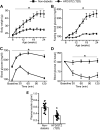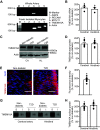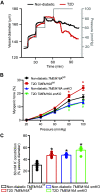TMEM16A channel upregulation in arterial smooth muscle cells produces vasoconstriction during diabetes
- PMID: 33449847
- PMCID: PMC7988758
- DOI: 10.1152/ajpheart.00690.2020
TMEM16A channel upregulation in arterial smooth muscle cells produces vasoconstriction during diabetes
Abstract
The pathological involvement of anion channels in vascular dysfunction that occurs during type 2 diabetes (T2D) is unclear. Here, we tested the hypothesis that TMEM16A, a calcium-activated chloride (Cl-) channel, contributes to modifications in arterial contractility during T2D. Our data indicate that T2D increased TMEM16A mRNA in arterial smooth muscle cells and total and surface TMEM16A protein in resistance-size cerebral and hindlimb arteries of mice. To examine vascular cell types in which TMEM16A protein increased and the functional consequences of TMEM16A upregulation during T2D, we generated tamoxifen-inducible, smooth muscle cell-specific TMEM16A knockout (TMEM16A smKO) mice. T2D increased both TMEM16A protein and Cl- current density in arterial smooth muscle cells of control (TMEM16Afl/fl) mice. In contrast, T2D did not alter arterial TMEM16A protein or Cl- current density in smooth muscle cells of TMEM16A smKO mice. Intravascular pressure stimulated greater vasoconstriction (myogenic tone) in the arteries of T2D TMEM16Afl/fl mice than in the arteries of nondiabetic TMEM16Afl/fl mice. This elevation in myogenic tone in response to T2D was abolished in the arteries of T2D TMEM16A smKO mice. T2D also reduced Akt2 protein and activity in the arteries of T2D mice. siRNA-mediated knockdown of Akt2, but not Akt1, increased arterial TMEM16A protein in nondiabetic mice. In summary, data indicate that T2D is associated with an increase in TMEM16A expression and currents in arterial smooth muscle cells that produces vasoconstriction. Data also suggest that a reduction in Akt2 function drives these pathological alterations during T2D.NEW & NOTEWORTHY We investigated the involvement of TMEM16A channels in vascular dysfunction during type 2 diabetes (T2D). TMEM16A message, protein, and currents were higher in smooth muscle cells of resistance-size arteries during T2D. Pressure stimulated greater vasoconstriction in the arteries of T2D mice that was abolished in the arteries of TMEM16A smKO mice. Akt2 protein and activity were both lower in T2D arteries, and Akt2 knockdown elevated TMEM16A protein. We propose that a decrease in Akt2 function stimulates TMEM16A expression in arterial smooth muscle cells, leading to vasoconstriction during T2D.
Keywords: Akt; TMEM16A channel; arterial contractility; smooth muscle; type 2 diabetes.
Conflict of interest statement
No conflicts of interest, financial or otherwise, are declared by the authors.
Figures






Similar articles
-
Extracellular glucose and dysfunctional insulin receptor signaling independently upregulate arterial smooth muscle TMEM16A expression.Am J Physiol Cell Physiol. 2024 Apr 1;326(4):C1237-C1247. doi: 10.1152/ajpcell.00555.2023. Epub 2024 Mar 4. Am J Physiol Cell Physiol. 2024. PMID: 38581667 Free PMC article.
-
Variable Contribution of TMEM16A to Tone in Murine Arterial Vasculature.Basic Clin Pharmacol Toxicol. 2018 Jul;123(1):30-41. doi: 10.1111/bcpt.12984. Epub 2018 Mar 30. Basic Clin Pharmacol Toxicol. 2018. PMID: 29438598
-
TMEM16A/ANO1 channels contribute to the myogenic response in cerebral arteries.Circ Res. 2012 Sep 28;111(8):1027-36. doi: 10.1161/CIRCRESAHA.112.277145. Epub 2012 Aug 7. Circ Res. 2012. PMID: 22872152 Free PMC article.
-
Regulation of vascular tone and arterial blood pressure: role of chloride transport in vascular smooth muscle.Pflugers Arch. 2015 Mar;467(3):605-14. doi: 10.1007/s00424-014-1684-y. Epub 2015 Jan 16. Pflugers Arch. 2015. PMID: 25588975 Review.
-
Aging, calcium channel signaling and vascular tone.Mech Ageing Dev. 2020 Oct;191:111336. doi: 10.1016/j.mad.2020.111336. Epub 2020 Sep 9. Mech Ageing Dev. 2020. PMID: 32918949 Free PMC article. Review.
Cited by
-
IP3R1 underlies diastolic ANO1 activation and pressure-dependent chronotropy in lymphatic collecting vessels.J Gen Physiol. 2023 Dec 4;155(12):e202313358. doi: 10.1085/jgp.202313358. Epub 2023 Oct 18. J Gen Physiol. 2023. PMID: 37851027 Free PMC article.
-
Extracellular glucose and dysfunctional insulin receptor signaling independently upregulate arterial smooth muscle TMEM16A expression.Am J Physiol Cell Physiol. 2024 Apr 1;326(4):C1237-C1247. doi: 10.1152/ajpcell.00555.2023. Epub 2024 Mar 4. Am J Physiol Cell Physiol. 2024. PMID: 38581667 Free PMC article.
-
TMEM16A in smooth muscle cells acts as a pacemaker channel in the internal anal sphincter.Commun Biol. 2024 Feb 5;7(1):151. doi: 10.1038/s42003-024-05850-1. Commun Biol. 2024. PMID: 38317010 Free PMC article.
-
Vasodilators activate the anion channel TMEM16A in endothelial cells to reduce blood pressure.Sci Signal. 2023 Nov 14;16(811):eadh9399. doi: 10.1126/scisignal.adh9399. Epub 2023 Nov 14. Sci Signal. 2023. PMID: 37963195 Free PMC article.
-
The mitochondrial regulation of smooth muscle cell proliferation in type 2 diabetes.bioRxiv [Preprint]. 2023 Feb 16:2023.02.15.528765. doi: 10.1101/2023.02.15.528765. bioRxiv. 2023. Update in: Int J Mol Sci. 2023 Aug 17;24(16):12897. doi: 10.3390/ijms241612897. PMID: 36824758 Free PMC article. Updated. Preprint.
References
-
- Centers for Disease Control and Prevention. National Diabetes Statistics Report Atlanta, Atlanta, GA: Centers for Disease Control and Prevention, U.S. Dept of Health and Human Services, 2017.
Publication types
MeSH terms
Substances
Grants and funding
LinkOut - more resources
Full Text Sources
Other Literature Sources
Medical
Molecular Biology Databases
Miscellaneous

